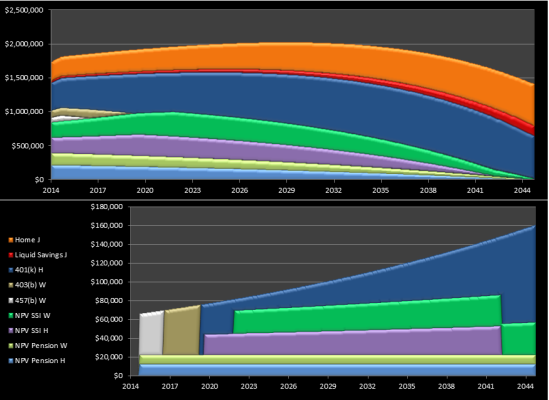Theseus
Recycles dryer sheets
- Joined
- Aug 4, 2013
- Messages
- 484
Attached is an Excel output chart showing current/projected NW including NPV of pensions and SS, and expenses with funding by source.
I've been planning for years now, and have recently brought DW up to speed on how I believe we are doing - which is that ER summer of 2014 is doable.
My assumptions are based on using past three years spending as a starting point, adding HI costs with HCA subsidy with AGI around 380% FPL with max HSA contribution to either defray OOP or become savings for future healthcare costs, adding in estimated taxes to calculate the required withdrawal, and using a generous lifespan putting us both into around 33% probability of actually reaching that age - an 8/1/14 ER returns a FireCalc Success Rate = 99.1%
My current age 56.5, DW 58.2 (on 8/1/14 I will be 57.0, DW 58.8).
My 401(k) tax deferred savings of $408k (monthly contribution $1,458 + $333 emp match) DW 403(b) tax deferred savings of $105k (monthly contribution $780), DW 457(b) tax deferred savings of $66k (monthly contribution $1,334). 457 plan allows withdrawal before age 59.5, we will use that to bridge from DW age 58.9 to 60.7. 403 withdrawals from DW 60.7 to 63.4, at which point I will be 61.7 and we begin drawing from my 401.
My Non-Cola pension @ 100% survivor $1,021 month, DW Non-Cola pension @ 100% survivor $810 month. We have both had health issues last few years, and realize the storybook ending scenario of each of us passing of natural causes within days of each other is not likely.
My SS @ age 62 $1,676 month, DW SS @ age 66 $1,836 month. I assume 3.0% inflation, and limit future SS increases at 50% of that as a hedge against future haircuts to SS benefits.
Residence valued at $285k free and clear. Plan calls for sale of home at my age 72, with a 2% annual appreciation rate. Depending how we feel about it then, may replace with warmer climate retiree community residence, condo, or maybe rents/snowbird – that is a future decision to be made. So I just say we keep that money invested in a home of some sort.
Investment returns until ER estimated at 8%, 6% after ER. Current mix 56% equities, 44% "safe" stuff.
Future inheritance in the mix also, being the named executor I am in a position to know more about that, but still prefer not to use it in the plan to keep it more conservative. Unless DM has some extraordinary needs coming up, we will probably see enough from the estate to make things more comfortable in terms of reducing money concerns to near nil.
Am I missing something?

I've been planning for years now, and have recently brought DW up to speed on how I believe we are doing - which is that ER summer of 2014 is doable.
My assumptions are based on using past three years spending as a starting point, adding HI costs with HCA subsidy with AGI around 380% FPL with max HSA contribution to either defray OOP or become savings for future healthcare costs, adding in estimated taxes to calculate the required withdrawal, and using a generous lifespan putting us both into around 33% probability of actually reaching that age - an 8/1/14 ER returns a FireCalc Success Rate = 99.1%
My current age 56.5, DW 58.2 (on 8/1/14 I will be 57.0, DW 58.8).
My 401(k) tax deferred savings of $408k (monthly contribution $1,458 + $333 emp match) DW 403(b) tax deferred savings of $105k (monthly contribution $780), DW 457(b) tax deferred savings of $66k (monthly contribution $1,334). 457 plan allows withdrawal before age 59.5, we will use that to bridge from DW age 58.9 to 60.7. 403 withdrawals from DW 60.7 to 63.4, at which point I will be 61.7 and we begin drawing from my 401.
My Non-Cola pension @ 100% survivor $1,021 month, DW Non-Cola pension @ 100% survivor $810 month. We have both had health issues last few years, and realize the storybook ending scenario of each of us passing of natural causes within days of each other is not likely.
My SS @ age 62 $1,676 month, DW SS @ age 66 $1,836 month. I assume 3.0% inflation, and limit future SS increases at 50% of that as a hedge against future haircuts to SS benefits.
Residence valued at $285k free and clear. Plan calls for sale of home at my age 72, with a 2% annual appreciation rate. Depending how we feel about it then, may replace with warmer climate retiree community residence, condo, or maybe rents/snowbird – that is a future decision to be made. So I just say we keep that money invested in a home of some sort.
Investment returns until ER estimated at 8%, 6% after ER. Current mix 56% equities, 44% "safe" stuff.
Future inheritance in the mix also, being the named executor I am in a position to know more about that, but still prefer not to use it in the plan to keep it more conservative. Unless DM has some extraordinary needs coming up, we will probably see enough from the estate to make things more comfortable in terms of reducing money concerns to near nil.
Am I missing something?

